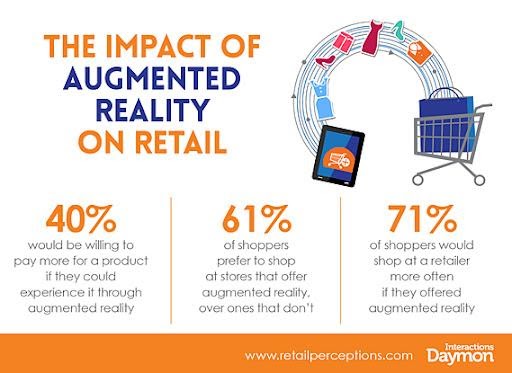Politics
How Augmented Reality Continues to Transform Customer Experience?
Published
3 years agoon
By
Drew Simpson
Augmented reality (AR) is continuously paving the way for more engaging interactions between businesses and their target customers. In more ways than one, AR-based customer experience can ensure increased customer satisfaction and business conversion.
According to a study, a whopping 71% of customers have very favorable opinions about AR in the shopping experience. They say it would urge them to buy from the store more often.
Augmented Reality (AR), which works as an overlaying aspect over the appearance of the physical objects and the world at large, can enhance the perception of the real world and thus can revolutionize the customer and shopping experience.
Source: retailperceptions
With the present mobile support for a three-dimensional view of the objects, delivering AR-powered shopping and customer experience across online stores and mobile stores has become more accessible.
According to a Tractica report, by 2022, the number of monthly active users for mobile augmented reality apps is likely to reach 1.9 billion.
Augmented reality-based customer experience promises a digital shopping and browsing experience transforming the entire customer journey with either immersive attributes or more meaningful interactions or more layers of information. Businesses that employ a developer to build an AR app equipped with AR experience should insist on making things easier for the customers.
Since AR, for improving the customer experience, offers so many promises, it is essential to look at the key ways AR can transform customer experience altogether.
Removes All Pre-purchase Uncertainty and Confusion

Despite the rapid growth story of e-commerce and mobile commerce stores across all niches and categories, the confusion and uncertainty about making purchases are still dominant for most customers buying online.
Since while buying online, people cannot try the products in person, the rates of product return and abandoned carts are considerably high compared to the brick and mortar stores.
This is exactly where AR can play an essential role by bridging the gap between the physical shopping experience and the online ones. Thanks to AR, online stores and mobile commerce stores can deliver a truly feel-real impression of the purchased products.
Already many stores have started to incorporate AR for the express purpose of offering an immersive shopping experience. The IKEA furniture store right on our smartphone allows you to see each furniture piece in your room.
Similarly, several garment and fashion accessory brands enable you to visualise the items on your body. For example, Gucci offers an AR trial feature so that customers can see their sneakers adorning their feet just by capturing the feet with the smartphone camera.
Delivering a Detailed Layer of Product Information
Augmented Reality (AR), besides offering an immersive and engaging way of trying the products before purchases, also ensures feting very detailed product information to the customers instantly. The best thing is this ability made AR-powered shopping popular for offline stores as well.
No wonder that in Japan, a whopping 66% of customers now expect regular brick and mortar stores to provide AR experiences. As far as understanding the production cost of the app with AR experience is concerned, this can ensure better business conversion and hence is worth the cost.
AR-based shopping and customer service can offer a lot of information instantly and guide customers navigating in a commercial space or a destination. No wonder travel companies are now utilizing AR to deliver guided tours to their customers.
While booking bus tickets or booking tickets for a sports arena or booking tickets of flights, now AR-based displays can show you the details of every seat along with the facilities to make highly informed purchases.
Already sprawling museum premises and large indoor sites in many parts of the world are helping the incoming visitors to navigate their ways with augmented reality-based interactive maps. Airliners can also guide their customers to navigate to the right gates in quick time.
Adding More Value Through Interactive Packaging
In a multitude of ways, augmented reality (AR) is making a positive impact on customer service, starting from pre-sale orders to the actual purchase experience. Interactive packaging is the latest example of this impact.
When scanning the product packages with their smartphone camera, customers can see very detailed and multilayered visuals with a lot of additional and helpful information. This results in more purchase decisions for the customers.
Heinz uses AR-based packaging to allow customers to get a lot of helpful information when purchasing tomato ketchup, an excellent example of this AR-powered interactive packaging.
There is no dearth of brands that allow customers to scan the QR code to get more detailed information about the products they are going to purchase. In business-to-business (B2B), customer communication can be highly useful. Instead of carrying brochures, visiting cards, or business presentations, you can allow your audience to scan a code to get the details.
Futuristic AR Based Dining Experience
For food and restaurant chains to receive a continuous flow of new customers and retain old customers, providing a smooth and frictionless experience became the established norm. Augmented reality (AR) in the food and beverage industry has already proved to boost customer engagement and improve brand loyalty.
There are already AR-based menus that are transforming food ordering for customers. Besides offering interactive 360-degree visuals of the food items, the latest AR-based food menu provides multiple layers of information and interactive overlays for the customers to customize before placing the orders.
Thanks to AR scanning, the food package labels have also become more accessible than ever before.
AR Powered Travel and Hospitality
If one industry we need to name has received the most significant impact of AR technology, none other than the travel and hospitality industry. AR-powered information overlays or navigational guidance appearing right on the smartphone screens completely revolutionized the traveler experience.
The Interactive virtual tours of travel sites, hotels, and restaurants offering an immersive, 360 degrees interactive visual of the sites and ambiance of premises added value to the travel experience in a never-before manner.
AR is also ensuring a highly reliable travel guide offering route and navigation guidance in real-time. Last but not least, modern translation apps providing a real-time translation of displayed signs is another excellent example of AR’s impact on the travel experience.
AR to Revolutionize Post Sales Support 
Source: techseedotme
In today’s competitive business environment, every brand needs to establish its reliability through robust and uncompromising post-sales support. Such support refers to all the activities after a product is sold or a service is offered to the customers.
Some of the crucial post-sales support mechanisms that matter for branding and customer appreciation include installation, upgrades, warranties, repairs, troubleshooting, and answering customer queries.
In this respect, remote augmented reality-based customer support has already proved to be a significant way to push changes. It helped increase call resolution at the first instance by at least 20%, and the AR-based support also helped reduce the rate of dispatching technicians by at least 17%.
AR is transforming post-sales support for brands in two significant ways through AR-powered self-service and AR-powered technical support.
Business brands are increasingly using AR to help customers with self-service support. On their smartphones, customers can get guidance through highly interactive visuals and media, screen overlays on technical aspects and quick FAQ answers.
- AR-based Technical Support
The AR-based visual support can also help customers understand the technically demanding aspects of various products, parts, the ways they function, and the particular measures of troubleshooting and problem-solving. An AR-based screen overlay can give details of all parts along with the model number, manufacturing details, versions and the problem resolution timing.
All those bulky user manuals written in multiple languages are already on their way to exit. They are being replaced by interactive AR-powered user manuals showing minute details of every component and how to operate a device with switches, buttons and other controls. For instance, a new car owner can take interactive visual guidance on different systems and car mechanisms after purchasing the vehicle.
Conclusion
Quite convincingly, AR has transformed the customer experience across e-commerce stores, brick and mortar stores and all other B2C and B2B interactions. AR has proved to be the most critical value addition impacting the customer experience.
Wasim Charoliya
Digital Marketing Strategist
Wasim Charoliya is a digital marketing consultant and strategist. He is passionate about helping startups, enterprises, B2B and SaaS businesses to establish thought leadership in their industry with actionable content strategy.
You may like
-


Chinese apps are letting public juries settle customer disputes
-


The pain is real. The painkillers are virtual reality.
-


Huawei’s 5G chip breakthrough needs a reality check
-


Customer experience horizons
-


Using data, AI, and cloud to transform real estate
-


Using Augmented Reality to Level up your E-Commerce Business
Politics
Fintech Kennek raises $12.5M seed round to digitize lending
Published
7 months agoon
10/11/2023By
Drew Simpson
London-based fintech startup Kennek has raised $12.5 million in seed funding to expand its lending operating system.
According to an Oct. 10 tech.eu report, the round was led by HV Capital and included participation from Dutch Founders Fund, AlbionVC, FFVC, Plug & Play Ventures, and Syndicate One. Kennek offers software-as-a-service tools to help non-bank lenders streamline their operations using open banking, open finance, and payments.
The platform aims to automate time-consuming manual tasks and consolidate fragmented data to simplify lending. Xavier De Pauw, founder of Kennek said:
“Until kennek, lenders had to devote countless hours to menial operational tasks and deal with jumbled and hard-coded data – which makes every other part of lending a headache. As former lenders ourselves, we lived and breathed these frustrations, and built kennek to make them a thing of the past.”
The company said the latest funding round was oversubscribed and closed quickly despite the challenging fundraising environment. The new capital will be used to expand Kennek’s engineering team and strengthen its market position in the UK while exploring expansion into other European markets. Barbod Namini, Partner at lead investor HV Capital, commented on the investment:
“Kennek has developed an ambitious and genuinely unique proposition which we think can be the foundation of the entire alternative lending space. […] It is a complicated market and a solution that brings together all information and stakeholders onto a single platform is highly compelling for both lenders & the ecosystem as a whole.”
The fintech lending space has grown rapidly in recent years, but many lenders still rely on legacy systems and manual processes that limit efficiency and scalability. Kennek aims to leverage open banking and data integration to provide lenders with a more streamlined, automated lending experience.
The seed funding will allow the London-based startup to continue developing its platform and expanding its team to meet demand from non-bank lenders looking to digitize operations. Kennek’s focus on the UK and Europe also comes amid rising adoption of open banking and open finance in the regions.
Featured Image Credit: Photo from Kennek.io; Thank you!
Radek Zielinski
Radek Zielinski is an experienced technology and financial journalist with a passion for cybersecurity and futurology.
Politics
Fortune 500’s race for generative AI breakthroughs
Published
7 months agoon
10/11/2023By
Drew Simpson
As excitement around generative AI grows, Fortune 500 companies, including Goldman Sachs, are carefully examining the possible applications of this technology. A recent survey of U.S. executives indicated that 60% believe generative AI will substantially impact their businesses in the long term. However, they anticipate a one to two-year timeframe before implementing their initial solutions. This optimism stems from the potential of generative AI to revolutionize various aspects of businesses, from enhancing customer experiences to optimizing internal processes. In the short term, companies will likely focus on pilot projects and experimentation, gradually integrating generative AI into their operations as they witness its positive influence on efficiency and profitability.
Goldman Sachs’ Cautious Approach to Implementing Generative AI
In a recent interview, Goldman Sachs CIO Marco Argenti revealed that the firm has not yet implemented any generative AI use cases. Instead, the company focuses on experimentation and setting high standards before adopting the technology. Argenti recognized the desire for outcomes in areas like developer and operational efficiency but emphasized ensuring precision before putting experimental AI use cases into production.
According to Argenti, striking the right balance between driving innovation and maintaining accuracy is crucial for successfully integrating generative AI within the firm. Goldman Sachs intends to continue exploring this emerging technology’s potential benefits and applications while diligently assessing risks to ensure it meets the company’s stringent quality standards.
One possible application for Goldman Sachs is in software development, where the company has observed a 20-40% productivity increase during its trials. The goal is for 1,000 developers to utilize generative AI tools by year’s end. However, Argenti emphasized that a well-defined expectation of return on investment is necessary before fully integrating generative AI into production.
To achieve this, the company plans to implement a systematic and strategic approach to adopting generative AI, ensuring that it complements and enhances the skills of its developers. Additionally, Goldman Sachs intends to evaluate the long-term impact of generative AI on their software development processes and the overall quality of the applications being developed.
Goldman Sachs’ approach to AI implementation goes beyond merely executing models. The firm has created a platform encompassing technical, legal, and compliance assessments to filter out improper content and keep track of all interactions. This comprehensive system ensures seamless integration of artificial intelligence in operations while adhering to regulatory standards and maintaining client confidentiality. Moreover, the platform continuously improves and adapts its algorithms, allowing Goldman Sachs to stay at the forefront of technology and offer its clients the most efficient and secure services.
Featured Image Credit: Photo by Google DeepMind; Pexels; Thank you!
Deanna Ritchie
Managing Editor at ReadWrite
Deanna is the Managing Editor at ReadWrite. Previously she worked as the Editor in Chief for Startup Grind and has over 20+ years of experience in content management and content development.
Politics
UK seizes web3 opportunity simplifying crypto regulations
Published
7 months agoon
10/10/2023By
Drew Simpson
As Web3 companies increasingly consider leaving the United States due to regulatory ambiguity, the United Kingdom must simplify its cryptocurrency regulations to attract these businesses. The conservative think tank Policy Exchange recently released a report detailing ten suggestions for improving Web3 regulation in the country. Among the recommendations are reducing liability for token holders in decentralized autonomous organizations (DAOs) and encouraging the Financial Conduct Authority (FCA) to adopt alternative Know Your Customer (KYC) methodologies, such as digital identities and blockchain analytics tools. These suggestions aim to position the UK as a hub for Web3 innovation and attract blockchain-based businesses looking for a more conducive regulatory environment.
Streamlining Cryptocurrency Regulations for Innovation
To make it easier for emerging Web3 companies to navigate existing legal frameworks and contribute to the UK’s digital economy growth, the government must streamline cryptocurrency regulations and adopt forward-looking approaches. By making the regulatory landscape clear and straightforward, the UK can create an environment that fosters innovation, growth, and competitiveness in the global fintech industry.
The Policy Exchange report also recommends not weakening self-hosted wallets or treating proof-of-stake (PoS) services as financial services. This approach aims to protect the fundamental principles of decentralization and user autonomy while strongly emphasizing security and regulatory compliance. By doing so, the UK can nurture an environment that encourages innovation and the continued growth of blockchain technology.
Despite recent strict measures by UK authorities, such as His Majesty’s Treasury and the FCA, toward the digital assets sector, the proposed changes in the Policy Exchange report strive to make the UK a more attractive location for Web3 enterprises. By adopting these suggestions, the UK can demonstrate its commitment to fostering innovation in the rapidly evolving blockchain and cryptocurrency industries while ensuring a robust and transparent regulatory environment.
The ongoing uncertainty surrounding cryptocurrency regulations in various countries has prompted Web3 companies to explore alternative jurisdictions with more precise legal frameworks. As the United States grapples with regulatory ambiguity, the United Kingdom can position itself as a hub for Web3 innovation by simplifying and streamlining its cryptocurrency regulations.
Featured Image Credit: Photo by Jonathan Borba; Pexels; Thank you!
Deanna Ritchie
Managing Editor at ReadWrite
Deanna is the Managing Editor at ReadWrite. Previously she worked as the Editor in Chief for Startup Grind and has over 20+ years of experience in content management and content development.
